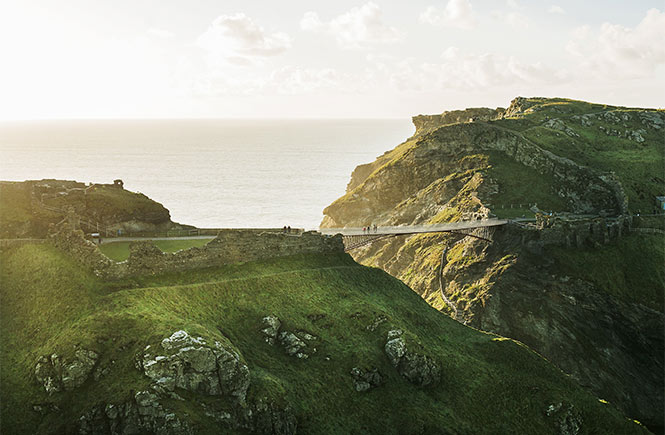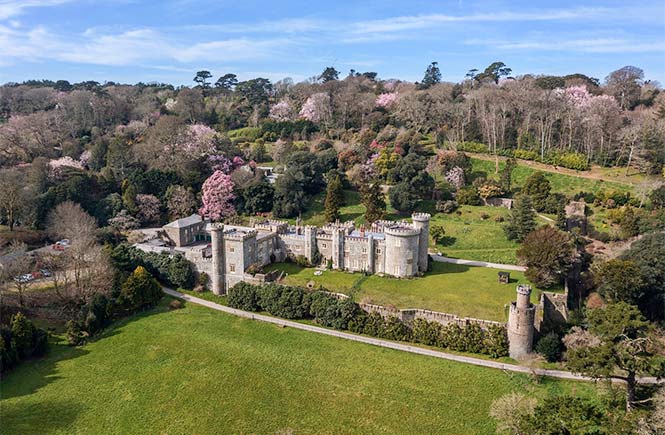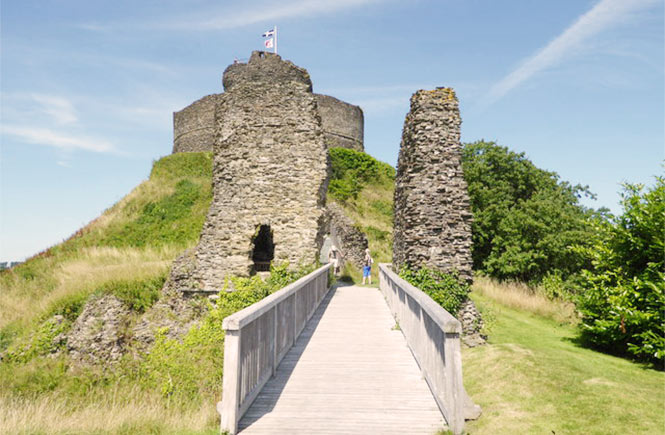From romantic island fortresses and prehistoric dwellings to castles shrouded in myth and legend, Cornwall is blessed with a wealth of historic buildings to explore.

Sweeping through the already beautiful landscape, castles bring a sense of character to the county, whether they’re bravely defending the estuaries and harbours from attack, showcasing the wealth of their landowners, or giving a peek into a portion of history we know little about.
Steeped in rich history, they’re often full of romance too, harking back to a time of courtly love and Arthurian legends. However, more often than not they speak of a darker past, where the threat of invasion, imprisonment, and the rule of the landowners made for a more tumultuous time. However you view it, exploring Cornwall’s impressive collection of castles makes for a fascinating day out!
Take a look at our top picks…
Tintagel Castle, Tintagel

Best for: Arthurian ambles
english-heritage.org.uk/visit/places/tintagel-castle
Castle Road, Tintagel PL34 0HE
Swathed in the myths and legends of King Arthur and his brave knights, epic Tintagel Castle on the north Cornish coast lies between Padstow and Bude, and has to be one of the most magical castles to be found in Cornwall, if not in the whole of Britain. Everything about your visit to this astonishing place is dramatic, from entering the medieval gateway to crossing the astonishing footbridge on to the island itself, where you’ll be bewitched by the stunning cliff top views.
Once you’re on the island you can explore the hauntingly beautiful ruins, where displays take you through the history of the 13th century castle and the buildings that surround it. There’s been a settlement here from at least the late Roman period, but it wasn’t until the 12th century that the area became known as the place where King Arthur was born, inspiring the immensely rich Richard, Earl of Cornwall, to build a castle there in the early 13th century. Sadly, the castle barely reached its 100th birthday before falling into ruin.
Take time to peek at the early medieval settlement, the medieval walled garden, and the defensive ditch at the castle entrance, as well as the outdoor works of art such as the majestic figure of ‘Gallos’, a life-sized bronze figure of King Arthur. For wildlife lovers, the cliffs of the island are a Site of Special Scientific Interest (SSSI) and home to flowers, coastal birds, and other wildlife – keep an eye out for seals bobbing in the waters below!
After you’ve explored the castle, head down to the beach, known as Tintagel Haven, to find Merlin’s Cave (accessible when the tide is out) and the impressive waterfall – a truly magical experience. If you’ve worked up an appetite with all that sea air, there’s a café on site that sells everything from coffee and cake to lunches, while afterwards have a stroll around the village of Tintagel and maybe visit the beautiful medieval building of the Old Post Office. Please note, to go on to the island you need to book a timed ticket to cross the bridge, which you can book online through English Heritage. The castle does sometimes close on days with high winds and bad weather, so do ring ahead if you’re unsure. Whatever the weather, sturdy footwear is recommended as the landscape is rugged, uneven, and bumpy in places.
St Michael’s Mount, Marazion

Best for: Waterside views
stmichaelsmount.co.uk
Marazion TR17 0HS
Standing proud in Mount’s Bay opposite Marazion, the image of St Michael’s Mount is recognised the world over. Accessible by a causeway when the tide is low or by boat when the tide is high, this famous island is one of the major highlights of Cornwall not to be missed when on holiday. Encircled by trees and subtropical gardens, the 12th century castle and church rises over the island, and has been the home of the St Aubyn family since the mid -17th century – as well as (supposedly) a giant!
Once you’ve crossed over to the island, it’s a lovely winding walk along cobbled pathways to the main entrance, the steep ascent well worth it for the incredible views at the top. Inside, you’ll discover a treasure trove of collectables and antiques, such as a clock that tells the tide times as well as the hour of the day, a piece of Napoleon’s coat worn at the Battle of Waterloo, a mummified cat (a souvenir from a trip to Egypt!), and the sofa on which Queen Victoria sat and had a cup of tea.
Managed by the National Trust, the castle retains much of its quirky character and feels very much like a lived-in home as you wander through the corridors and rooms of this incredible place, combined with the breathtaking sea views from every window. Once you’ve explored the castle, make sure to take time for a wander through the beautiful subtropical terraced garden, built into the granite cliffs in 1878 and a home for stunning flower beds and weaving walkways.
Afterwards, make your way back towards the harbour where you’ll find a fantastic café for a bite to eat and a gift shop. To visit the island, do check the website to make sure it’s open as times vary throughout the year, and the castle is closed during the winter months and during inclement weather. Our live webcam of St Michael’s Mount is ideal for weather watching and getting your Cornish fix!
Pendennis Castle, Falmouth

Best for: Family fun
english-heritage.org.uk/visit/places/pendennis-castle
Castle Drive, Falmouth TR11 4LP
One of the best examples of England’s coastal fortresses, Pendennis Castle lies on a headland on the outskirts of Falmouth and was built on the orders of King Henry VIII between 1539 and 1545 out of fear of an imminent Catholic European invasion. Overlooking the harbour and the estuary of the Fal River, the castles’ circular construction was built to easily allow cannons to fire from all directions alongside another fortress across the harbour in St Mawes.
When it was believed the coast was due to be invaded, Pendennis would have been inhabited by up to 100 men who would keep lookout throughout the day and night. Eventually, a larger fortress was built around the castle making it even more formidable, and it became a Royalist stronghold during the Civil War that was only relinquished due to a lack of supplies. In recent years, Pendennis became the west Cornish command centre for coastal defences during the First World War, while during the Second World War it was engaged to deal with the threat of enemy torpedo boats and equipped with far-reaching guns.
Today, the castle is managed by English Heritage and offers a fascinating day out where you can learn what life would have been like for the Tudor soldiers who lived and worked there. It’s a great place for kids too, with a family trail to follow and a soft play area. Grownups will love the fascinating exhibitions, panoramic sea views (especially from Henry VIII’s keep), and the incredible collection of Tudor, Napoleonic, Victorian and 20th century weaponry. If you get peckish, there’s a café on site too - not to mention Falmouth’s impressive collection of mouthwatering pubs, bars, and restaurants.
St Mawes Castle, St Mawes

Best for: Beautiful battlements
english-heritage.org.uk/visit/places/st-mawes-castle
Castle Drive, St Mawes TR2 5DE
The counterpart to Pendennis, St Mawes Castle lies across the water and is an equally impressive Tudor fortress built under instruction by Henry VIII. Clover leaf in shape, it’s considered to be one of the prettiest of England’s fortresses and offers gorgeous views over the estuary and out to sea.
Surrounded by beautifully kept gardens, inside you can find out what life was like for the men who lived there, keeping guard against Catholic invasion. As you wander through the rooms, you’ll catch a glimpse of ancient carvings flattering Henry VIII and his son Edward, as well as be able to peer down an ‘oubliette’ (a deep hole where unruly prisoners were kept), see the replica guns on the gun platform, and the kitchen.
There’s lots of displays around to give a deeper insight into life in the castle, while little ones might like to take part in the trail that explores the site. Afterwards, make sure to take a stroll into the pretty village of St Mawes for a bite to eat and maybe some time on the lovely beach below.
Caerhays Castle and Gardens, near Mevagissey

Best for: Gorgeous gardens
visit.caerhays.co.uk
Gorran Churchtown, St Austell PL26 6LY
Built in the late 19th century, Caerhays Castle is an imposing estate overlooking Porthluney Cove near Mevagissey. Open usually from mid-March to mid-June for guided tours of the castle and mid-February to mid-June for the garden, Caerhays estate has had just two families own it since 1370, with the Williams family taking ownership in 1853. Today the castle showcases over 140 years of the Williams family’s collection of possessions, from Victorian jugs and crockery to Edwardian bric-a-brac, and is carefully looked after by a dedicated team who work hard to protect it all from wear and tear.
Carefully keeping the castles’ secrets close so as not to spoil the enjoyment of your first visit, not much is disclosed about what to expect within the castle walls, making it a mysterious and fascinating place to visit. More well known are the incredible 140 acres of stunning gardens and woodland, which were mainly developed at the turn of the 20th century. Filled with discoveries from trips to China, there are frothy masses of rhododendrons, azaleas, magnolias and camellias that dominate this extraordinary garden, making it a spring garden that’s at its best during the months of March, April, and May.
Caerhays is home to the national magnolia collection with over 450 types grown on site, as well as a huge range of rare woodland trees and shrubs mainly originating from China (including a stunning 100-year old magnolia tree), which can be seen from any of the four woodland trails that weave their way through the estate. You can also visit the privately owned Porthluney Beach, a gorgeous sandy beach that’s blissfully sheltered and secluded. It’s also safe for swimming here with a ban on any motorised watercraft to keep it a peaceful spot. The Magnolia Tea room is well worth a visit if you’re hungry as they serve light lunches, cakes, teas and coffees while the gift and plant shop are a must for gardeners and treasure-seekers alike.
Restormel Castle, Lostwithiel

Best for: Royal ruins
english-heritage.org.uk/visit/places/restormel-castle
Restormel Road, Lostwithiel PL22 0EE
Set overlooking the River Fowey and its valley, and not far from Lostwithiel, Restormel Castle is a grand, early 14th-century circular keep that’s been kept in surprisingly good nick. The original wooden motte and bailey castle was thought to have been built just after the Norman Conquest, but the remains we see today are of a luxurious castle that once belonged to Edward of Woodstock, the eldest son of Edward III, when Lostwithiel was the hub of Cornwall’s tin industry.
The castle remained the property of the future Princes of Wales and still belongs to the Duchy of Cornwall, although it’s looked after by English Heritage these days. Today, the ruins offer just a glimpse into its grandness, including the high windows, immense fireplaces and grand hall that are fascinating to explore. Take a walk along the inside of the keep, or climb the stone steps from the courtyard to enjoy extensive views of the surrounding countryside. Gorgeous in spring when the grounds, once a deer park, are flooded with bluebells and daffodils, it’s a bit of a wildlife haven as well as a wonderful spot for a picnic. There’s free car parking for 25 cars nearby, and further parking in Lostwithiel itself that’s a hilly 1-mile walk away.
Launceston Castle

Best for: Rolling views
english-heritage.org.uk/visit/places/launceston-castle
Castle Lodge, Launceston PL15 7DR
Towering over the town of Launceston, this castle was built just after the Norman conquest by William the Conqueror’s half-brother when Launceston was the county town of Cornwall. Used as the town’s headquarters, the castle’s elevated position meant it was able to watch over the town and surrounding estates with ease, controlling its inhabitants.
In the mid-13th century it was given to Richard, Earl of Cornwall by the king, who completely remodelled it to his liking, although he rarely visited it – about six times in total. It did, however, remain the administrative centre of his earldom where he amassed great wealth through mining tin. Later on, the castle became a jail (George Fox, the founder of the Quakers, was once prisoner here), and gained the nickname ‘Castle Terrible’ for the execution of 28 Cornish people following the murder of a religious man who removed and destroyed statues of saints from their churches.
With its grim reputation, it held its position as a jail and courthouse for many years, before gradually falling into disrepair by the 18th century when its grounds were turned into a pleasure garden. It briefly came back into use again in the Second World War when part of it was used as a hospital for US soldiers, and the same area was used as government buildings right up to the 1960s.
Today, the castle is managed by English Heritage and there’s a small museum and exhibition on site, tracing the 1,000 years of the castle’s history with artefacts and archaeological finds, while the gardens around the motte are a fantastic spot for a picnic. Children can try their hand at archery or dress up as an ancient local, while there’s a shop on site to pick up a memento from your visit. There’s no parking on site but there are car parks in the centre of Launceston within a 10-15 minute walk (disabled parking available by prior arrangement). The castle closes for winter so do check the website for opening times.
Other castles and forts to explore

If you’re looking for other historical spots to visit, Cornwall has plenty more on offer. In Fowey, take the 4-mile walk from the town via Ready Money Beach to nearby St Catherine’s Castle, a small artillery fort built by Henry VIII in the 1530’s to defend Fowey Harbour and later used in both the Crimean and Second World War.
The mysterious Roche Rock, a 66-foot-tall edifice (said to be the ruins of a medieval castle) topped by a 15th-century ruined chapel dedicated to St Michael, has been the subject of speculation for centuries, with tales of hermits, leprosy sufferers, and even evil spirits said to roam the wilds of Cornwall mulled over by locals and historians alike. You’ll find this spot just north of St Austell.
Castle-an-Dinas is an Iron Age hill fort not far from St Columb Major. One of the largest of its kind in Cornwall and standing at 700 metres above sea level, it offers panoramic views across both the north and south coast and consists of three ditches with rampart concentric rings, as well as two Bronze Age barrows.
Head west and you’ll find Pengersick Castle nestled amongst the houses in Praa Sands near Porthleven. Dating from the 16th century with pretty gardens, it’s reputedly one of the most haunted sites in Cornwall with 20 resident ghosts, from a monk and a dancing girl to a cat and a dog! You can visit here, but only by prior arrangement. Finally, Chûn Castle can be found on the summit of Chûn Downs near Morvah close to Penzance. Another Iron Age hillfort, it has impressive views over Mounts Bay to the south and the Atlantic coast to the north, with the remains of several stone walled round houses, a furnace, and animal pounds as well as pottery and stone artefacts.
If you’ve been inspired to take a historical holiday, take a look at our holiday cottages in Cornwall and book your getaway today.